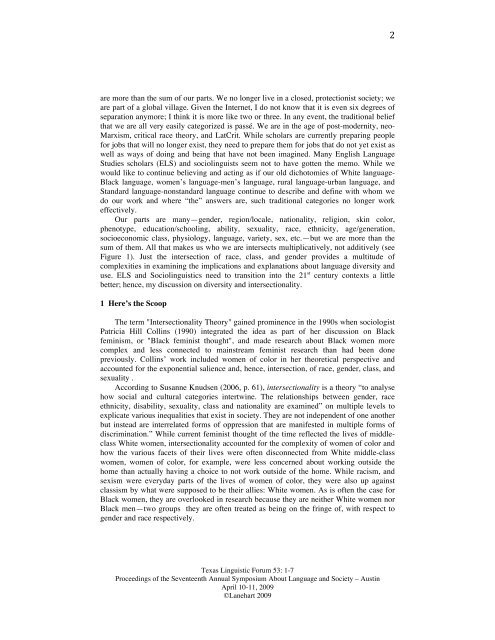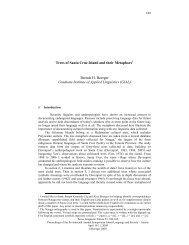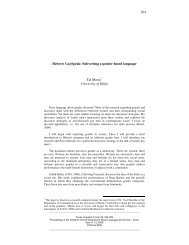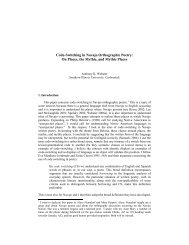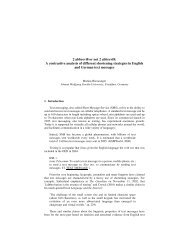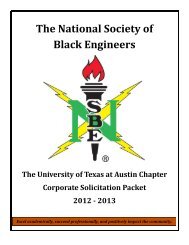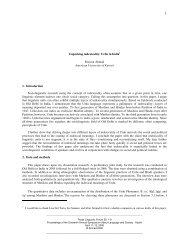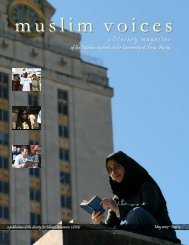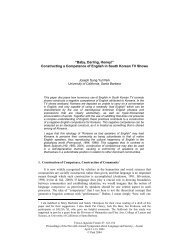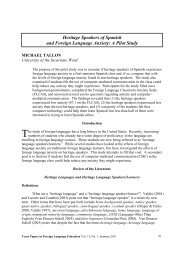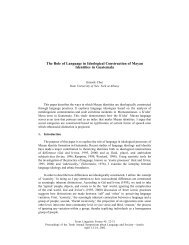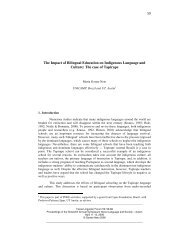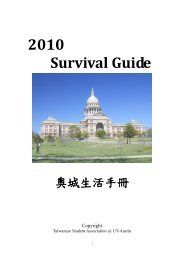Diversity and Intersectionality Sonja L. Lanehart University of Texas ...
Diversity and Intersectionality Sonja L. Lanehart University of Texas ...
Diversity and Intersectionality Sonja L. Lanehart University of Texas ...
Create successful ePaper yourself
Turn your PDF publications into a flip-book with our unique Google optimized e-Paper software.
<br />
are more than the sum <strong>of</strong> our parts. We no longer live in a closed, protectionist society; we<br />
are part <strong>of</strong> a global village. Given the Internet, I do not know that it is even six degrees <strong>of</strong><br />
separation anymore; I think it is more like two or three. In any event, the traditional belief<br />
that we are all very easily categorized is passé. We are in the age <strong>of</strong> post-modernity, neo-<br />
Marxism, critical race theory, <strong>and</strong> LatCrit. While scholars are currently preparing people<br />
for jobs that will no longer exist, they need to prepare them for jobs that do not yet exist as<br />
well as ways <strong>of</strong> doing <strong>and</strong> being that have not been imagined. Many English Language<br />
Studies scholars (ELS) <strong>and</strong> sociolinguists seem not to have gotten the memo. While we<br />
would like to continue believing <strong>and</strong> acting as if our old dichotomies <strong>of</strong> White language-<br />
Black language, women’s language-men’s language, rural language-urban language, <strong>and</strong><br />
St<strong>and</strong>ard language-nonst<strong>and</strong>ard language continue to describe <strong>and</strong> define with whom we<br />
do our work <strong>and</strong> where “the” answers are, such traditional categories no longer work<br />
effectively.<br />
Our parts are many—gender, region/locale, nationality, religion, skin color,<br />
phenotype, education/schooling, ability, sexuality, race, ethnicity, age/generation,<br />
socioeconomic class, physiology, language, variety, sex, etc.—but we are more than the<br />
sum <strong>of</strong> them. All that makes us who we are intersects multiplicatively, not additively (see<br />
Figure 1). Just the intersection <strong>of</strong> race, class, <strong>and</strong> gender provides a multitude <strong>of</strong><br />
complexities in examining the implications <strong>and</strong> explanations about language diversity <strong>and</strong><br />
use. ELS <strong>and</strong> Sociolinguistics need to transition into the 21 st century contexts a little<br />
better; hence, my discussion on diversity <strong>and</strong> intersectionality.<br />
1 Here’s the Scoop<br />
The term "<strong>Intersectionality</strong> Theory" gained prominence in the 1990s when sociologist<br />
Patricia Hill Collins (1990) integrated the idea as part <strong>of</strong> her discussion on Black<br />
feminism, or "Black feminist thought", <strong>and</strong> made research about Black women more<br />
complex <strong>and</strong> less connected to mainstream feminist research than had been done<br />
previously. Collins’ work included women <strong>of</strong> color in her theoretical perspective <strong>and</strong><br />
accounted for the exponential salience <strong>and</strong>, hence, intersection, <strong>of</strong> race, gender, class, <strong>and</strong><br />
sexuality .<br />
According to Susanne Knudsen (2006, p. 61), intersectionality is a theory “to analyse<br />
how social <strong>and</strong> cultural categories intertwine. The relationships between gender, race<br />
ethnicity, disability, sexuality, class <strong>and</strong> nationality are examined” on multiple levels to<br />
explicate various inequalities that exist in society. They are not independent <strong>of</strong> one another<br />
but instead are interrelated forms <strong>of</strong> oppression that are manifested in multiple forms <strong>of</strong><br />
discrimination.” While current feminist thought <strong>of</strong> the time reflected the lives <strong>of</strong> middleclass<br />
White women, intersectionality accounted for the complexity <strong>of</strong> women <strong>of</strong> color <strong>and</strong><br />
how the various facets <strong>of</strong> their lives were <strong>of</strong>ten disconnected from White middle-class<br />
women, women <strong>of</strong> color, for example, were less concerned about working outside the<br />
home than actually having a choice to not work outside <strong>of</strong> the home. While racism, <strong>and</strong><br />
sexism were everyday parts <strong>of</strong> the lives <strong>of</strong> women <strong>of</strong> color, they were also up against<br />
classism by what were supposed to be their allies: White women. As is <strong>of</strong>ten the case for<br />
Black women, they are overlooked in research because they are neither White women nor<br />
Black men—two groups they are <strong>of</strong>ten treated as being on the fringe <strong>of</strong>, with respect to<br />
gender <strong>and</strong> race respectively.<br />
<br />
<strong>Texas</strong> Linguistic Forum 53: 1-7<br />
Proceedings <strong>of</strong> the Seventeenth Annual Symposium About Language <strong>and</strong> Society – Austin<br />
April 10-11, 2009<br />
©<strong>Lanehart</strong> 2009<br />
2


